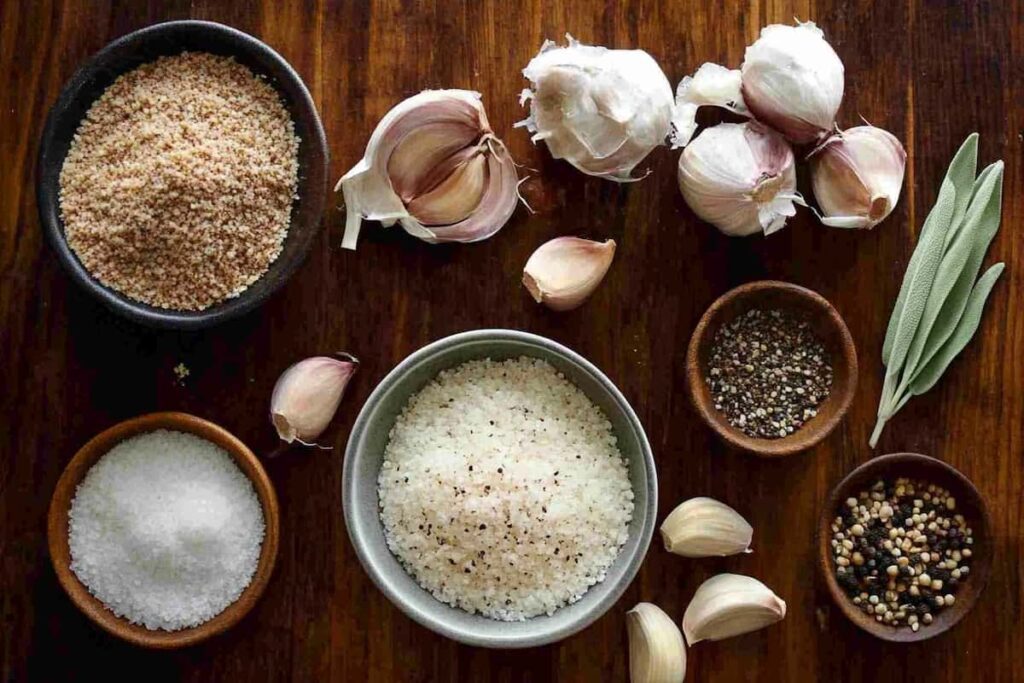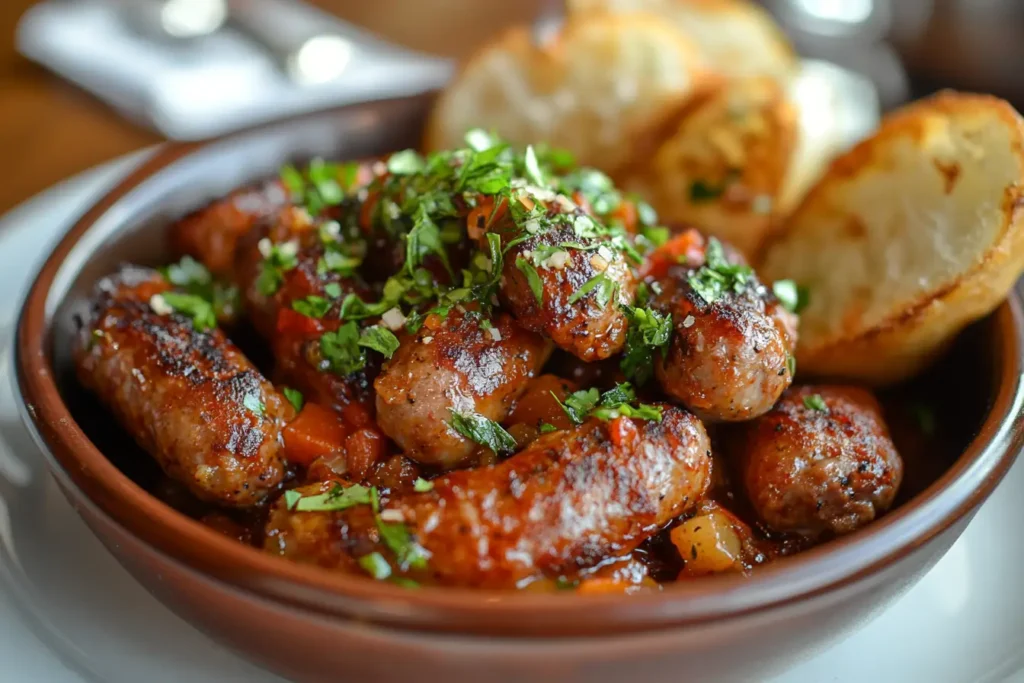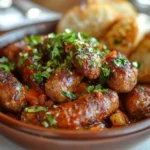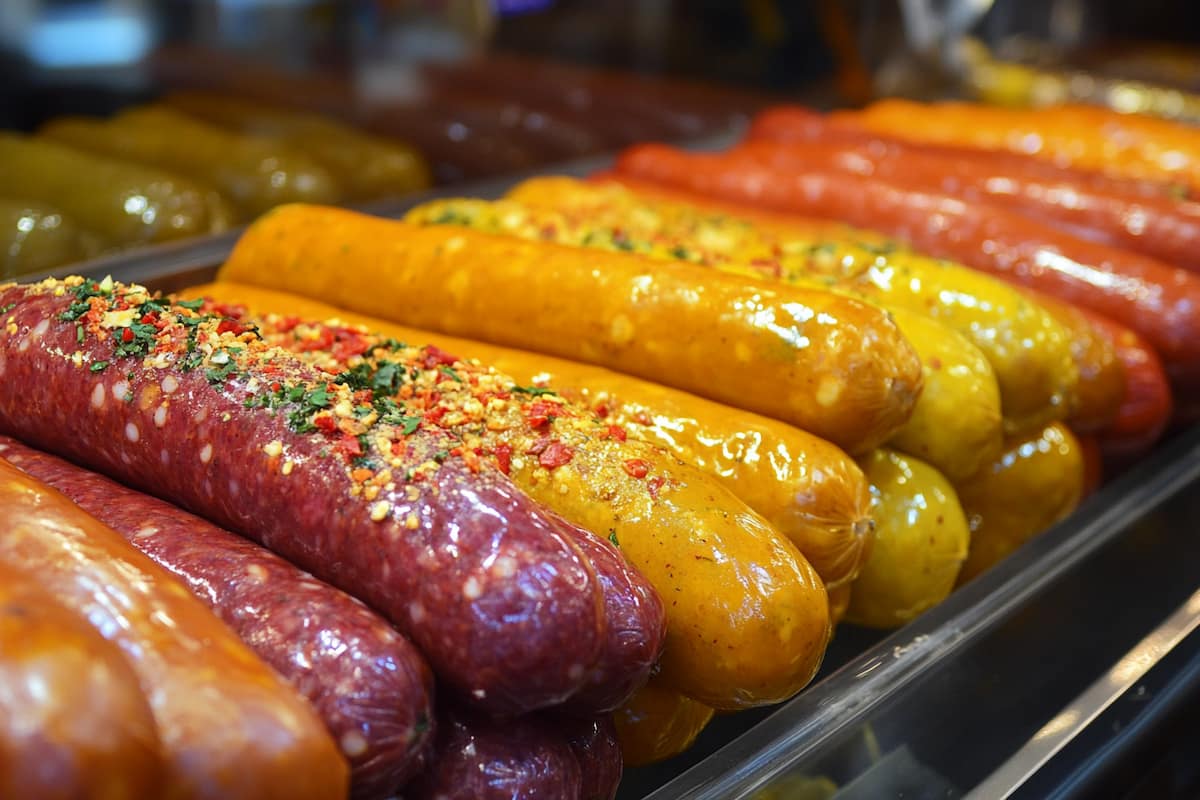Breakfast sausage meat blends ground meats, seasonings, and sometimes fillers. It’s made to be cooked and eaten as part of breakfast. Its unique mix makes it stand out from other sausages, making it a key part of many breakfasts. Knowing what goes into breakfast sausage helps us understand its taste and versatility.
Mixing ground meats like pork and beef and seasonings like salt and sage gives it a special taste. The ingredients and how they’re mixed up are key to its flavor and why people love it for breakfast.
Key Takeaways
- Breakfast sausage meat is a mixture of ground meats, seasonings, and fillers.
- The unique composition of breakfast sausage meat sets it apart from other types of sausage.
- Understanding breakfast sausage ingredients is essential to appreciate its flavour and versatility.
- Sausage meat composition plays a crucial role in defining its character.
- Typical seasonings like salt, pepper, and sage create a distinct flavor profile.
- Breakfast sausage is a staple in many breakfast dishes.
- The combination of ground meats and seasonings makes it a beloved breakfast food.
What Is Breakfast Sausage Meat?
Breakfast sausage meat is a key part of many meals. It comes in many types, each with its own mix of ingredients. These include ground meat, fat, seasonings, and sometimes preservatives. For thousands of years, people have enjoyed sausages, with each culture making its own version.
Over time, sausages have evolved into many different kinds, each with its own taste and texture. The ingredients used, such as pork, beef, chicken, and lamb, are mixed with spices and herbs are mixed to create unique flavors.
Basic Definition and Components
Breakfast sausage is a blend of ground meat, fat, and seasonings. There are many types, like pork sausage, chorizo, and bratwurst. Some sausages also have fillers, like breadcrumbs, to add texture.
Historical Background
Sausages have a long history, dating back to ancient times. Places like Greece and Rome had evidence of sausage use. Different cultures have made their own sausages, using various meats and spices to create unique flavors.
Key Characteristics
The flavor, texture, and smell of breakfast sausage are key. The type of meat and seasonings used affect its quality and taste. Whether you like classic pork sausage or something more exotic like chorizo, there’s a sausage for everyone.
Breakfast Sausage Meat: Essential Ingredients
Traditional breakfast sausage recipes rely on key ingredients for flavor and texture. Pork is a mainstay, offering a rich, savory taste. The mix of lean meat and fat makes the sausage juicy and tender.
Seasonings like sage and black pepper are also crucial. Sage is subtle and earthy, while black pepper adds a sharp, peppery taste. These are often mixed with other spices and herbs for a unique taste. Some recipes include fillers like breadcrumbs or grains to add bulk.
A traditional breakfast sausage recipe may include the following ingredients:
- Pork shoulder or butt
- Sage
- Black pepper
- Salt
- Breadcrumbs or grains (optional)

These ingredients form the base of a classic breakfast sausage. By mixing them in the right way, you can make a delicious, flavorful sausage.
Quality is key in whether you stick to traditional recipes or try new ingredients. With practice and patience, you can make an exceptional breakfast sausage.
The Signature Seasoning Blend
The signature seasoning blend makes breakfast sausage taste so good. It includes a mix of spices and herbs that complement the meat. Sausage seasoning is key, and it can change based on where you are and what you like.
Common spices in breakfast sausage seasoning are sage, black pepper, and salt. These give a savory taste that’s both balanced and tasty. Different places might add spices like paprika or garlic to make the flavor unique.
Primary Spices Used
- Sage: adds a savory, slightly bitter flavor
- Black pepper: adds a sharp, peppery flavor
- Salt: enhances the flavor of the other spices and herbs
Other than these main spices, breakfast sausage spices might also include herbs. These herbs are important for making the sausage taste even better. Knowing about the signature seasoning blend helps you make your own tasty breakfast sausage.
Ground Meat Selection and Quality
The quality of the ground meat in breakfast sausage greatly affects taste and texture. The meat’s origin, fat content, and how it’s ground all matter. To pick the best meat for your sausage, look at these factors:
Start with fresh, quality meat from a trusted source. The meat’s fat content is key for flavor and texture. Aim for 20-30% fat for a balanced taste and feel.
The grinding process is also vital for the quality of sausage meat. A coarse grind makes the sausage more textured. A fine grind makes it smoother. Your choice depends on what you like and the sausage’s texture you want.
Choosing high-quality ground meat ensures your sausage tastes great. Whether you make sausage at home or buy it, ground meat selection and sausage meat quality are crucial. They make your breakfast delicious and satisfying.
Breakfast Sausage Meat: The Manufacturing Process
Making breakfast sausage combines old methods with new technology. Sausage manufacturers choose between large-scale and artisanal methods, each with its own rules for keeping the product safe and good.
Big-scale methods use lots of machines and automation. This makes lots of sausages fast and the same. But artisanal sausage-making sticks to the old ways. It uses hands and top-notch ingredients for special tastes.
Industrial Production Methods
Big-scale methods aim for fast and lots. They include:
- Meat grinding and mixing
- Stuffing and linking
- Packaging and labeling
Artisanal Preparation Techniques
Artisanal sausage-making values quality and skill. It often means:
- Hand-picking ingredients
- Old-school curing and smoking
- Manual stuffing and linking
Quality Control Standards
Quality checks are key, no matter the method. They make sure the sausage is safe and good. This includes checks, tests, and approvals to follow the rules.
Nutritional Profile and Health Considerations
Knowing what’s in breakfast sausage is key when looking at sausage nutrition. A typical serving can have a lot of sodium, saturated fat, and nitrates. These can be bad for your health if you overeat.
Breakfast sausage contains proteins, fats, and sodium. Its health is important because eating too much can raise one’s risk of heart disease and some cancers. To make sausage part of a healthy diet, eat it in small amounts and with other healthy foods.
- Choose sausages with lower sodium content
- Opt for sausages made with leaner meats, such as turkey or chicken
- Pair sausage with other nutrient-dense foods, such as fruits and whole grains
Being aware of sausage nutrition and breakfast sausage health helps you enjoy sausage in a healthy way. Always check the nutrition label. Pick sausages that fit your diet and taste.
Breakfast Sausage Meat: Serving Suggestions and Cooking Methods
Breakfast sausage is very versatile. It can be cooked in many ways, making it perfect for any meal. You can pan-fry, grill, or bake it for tasty sausage recipes.
For a classic breakfast, cook sausage with oil or butter in a pan. This method gives the sausage a crispy outside and a juicy inside. Sausage is great with eggs, pancakes, and more. Try sausage and egg skillets, sausage and cheese omelets, or sausage and pancake sandwiches.
Serve your sausages with a quick, easy snack , such as this Torta Bread or Scrambled Eggs With Spinach, for a light yet satisfying treat.
Traditional Breakfast Preparations
- Pan-frying sausage with scrambled eggs and toast
- Grilling sausage and serving it with pancakes and syrup
- Baking sausage in a casserole with eggs, cheese, and bread
Modern cooking techniques can also make unique sausage recipes. Try slow-cooking sausage with veggies and sauce for a hearty stew. Or grill sausage with roasted veggies for a healthy meal.
Modern Cooking Techniques
Other ideas include sausage and pepper skewers, sausage and potato soup, or sausage and egg breakfast burritos. Experimenting with different methods and ingredients can lead to many delicious sausage recipes.

Breakfast Sausage Meat: Popular Varieties and Regional Differences
There are many types of breakfast sausage meat, each with its own taste and texture. These differences come from local tastes, ingredients, and traditions. TBreakfast sausage is a rich and varied world, from spicy sausages in the South to mild British bangers.
Country-style sausage and chorizo are just a few favorites. Regional differences lead to many unique sausages. For instance:
- Andouille sausage, a smoked sausage from Louisiana
- Knockwurst, a short, plump sausage from Germany
- Merguez, a spicy sausage from North Africa
These sausages show off local tastes and sausage-making creativity worldwide.

For a savory pairing, consider this Moroccan Shakshuka that complements the fresh flavors of breakfast sausage.
Types of Breakfast Sausage
Are you looking for something classic or adventurous? There’s a breakfast sausage for you. Exploring different sausages can add new flavors to your mornings.
| Region | Type of Sausage | Description |
|---|---|---|
| Southern United States | Country-style sausage | A blend of pork and seasonings often served with biscuits and gravy |
| Spain | Chorizo | A spicy sausage made with pork and smoked paprika |
| Germany | Knockwurst | A short, plump sausage made with a combination of pork and veal |
Conclusion: Understanding the Breakfast Sausage Meat Experience
The sausage experience is more than just food. It’s a big part of sausage culture. Its unique taste, how it’s made, and different versions in different places make it special. Learning about breakfast sausage means diving into its rich history and cultural importance.
Breakfast sausage is loved for its role in both classic and new dishes. It’s not just food but a way to unite people. Its flexibility and the effort put into making it show the beauty of cooking. Every bite we take connects us to our culinary past.
Frequently Asked Questions about Breakfast Sausage Meat
What is breakfast sausage meat made of?
Breakfast sausage consists of ground meats such as pork, beef, or both. It also includes seasonings like salt, pepper, and sage.
What are the key characteristics of breakfast sausage?
Breakfast sausage is known for its unique mix of ingredients. It contains more pork and a unique seasoning of sage and black pepper.
What are the essential ingredients in traditional breakfast sausage?
Traditional breakfast sausage contains pork, sage, black pepper, and sometimes fillers, which add bulk and texture.
What spices and herbs are used in the signature seasoning blend?
The blend in breakfast sausage often has sage, black pepper, and salt. Some places add thyme, rosemary, or fennel too.
How does the quality of the ground meat affect the taste and texture of breakfast sausage?
The mquality of the meatin breakfast sausage greatly affects its taste and texture. The meat’s origin, fat content, and hgroundness alsomatter a lot.
What are the different methods used in the manufacturing of breakfast sausage?
Breakfast sausage can be made using industrial or hand methods. Each method has its own standards and methods.
What are the health considerations when it comes to consuming breakfast sausage?
Breakfast sausage can be high in sodium, saturated fat, and nitrates. Eating too much or as part of an unbalanced diet can be a health risk.
How can breakfast sausage be cooked and served?
Breakfast sausage can be cooked in many ways, like pan-frying, grilling, or baking. It’s often served with eggs and pancakes.
What are the popular varieties and regional differences in breakfast sausage?
There are many types of breakfast sausage, each with its own taste and ingredients. These vary by region, reflecting local tastes and traditions.
Print
Merguez Sausage
- Total Time: 25 minutes
- Yield: 4 Servings 1x
- Diet: Gluten Free
Description
Merguez sausage is a spicy North African sausage made with lamb or beef, seasoned with harissa, garlic, and aromatic spices like cumin and coriander. Its deep red color and bold flavors make it a popular ingredient in Middle Eastern and Mediterranean cuisine, perfect for grilling, frying, or stewing.
Ingredients
- 1 pound ground lamb (or a mix of lamb and beef)
- 2 tablespoons harissa paste
- 2 teaspoons smoked paprika
- 1 teaspoon ground cumin
- 1 teaspoon ground coriander
- 1 teaspoon salt
- 1/2 teaspoon black pepper
- 1/2 teaspoon cayenne pepper (optional, for extra heat)
- 3 garlic cloves, minced
- 2 tablespoons chopped fresh parsley or cilantro
- 1 tablespoon olive oil (optional, for juiciness)
Instructions
- Prepare the Spice Blend: In a small bowl, mix harissa, paprika, cumin, coriander, salt, black pepper, and cayenne pepper.
- Combine with Meat: In a large bowl, add the ground lamb and garlic. Sprinkle the spice blend over the meat and mix thoroughly with your hands. Add parsley or cilantro for freshness.
- Shape the Sausages: Form the mixture into sausage shapes or patties. Alternatively, stuff it into sausage casings if desired.
- Cook: Heat a grill or skillet over medium heat. Cook the sausages for 3-4 minutes per side until browned and cooked through. The internal temperature should reach 160°F (71°C).
- Serve: Pair with couscous, flatbreads, or a side salad for a complete meal.
Notes
- For a milder flavor, reduce the amount of harissa or cayenne.
- Merguez sausages can be frozen raw for up to 3 months.
- If using sausage casings, soak them in water for 30 minutes before stuffing.
- Prep Time: 15 minutes
- Cook Time: 10 minutes
- Category: Main Course
- Method: Grilling or Pan-frying
- Cuisine: North African, Mediterranean
Nutrition
- Serving Size: 1 sausage (approx. 4 oz)
- Calories: 250
- Sugar: 1g
- Sodium: 450mg
- Fat: 20g
- Saturated Fat: 8g
- Unsaturated Fat: 12g
- Trans Fat: 0g
- Carbohydrates: 2g
- Fiber: 0g
- Protein: 18g
- Cholesterol: 70mg



